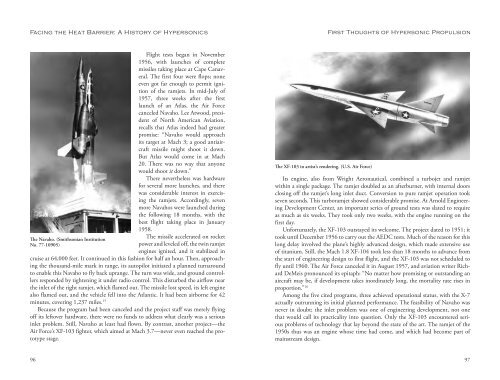Facing the Heat Barrier - NASA's History Office
Facing the Heat Barrier - NASA's History Office
Facing the Heat Barrier - NASA's History Office
Create successful ePaper yourself
Turn your PDF publications into a flip-book with our unique Google optimized e-Paper software.
<strong>Facing</strong> <strong>the</strong> <strong>Heat</strong> <strong>Barrier</strong>: A <strong>History</strong> of Hypersonics<br />
The Navaho. (Smithsonian Institution<br />
No. 77-10905)<br />
96<br />
Flight tests began in November<br />
1956, with launches of complete<br />
missiles taking place at Cape Canaveral.<br />
The first four were flops; none<br />
even got far enough to permit ignition<br />
of <strong>the</strong> ramjets. In mid-July of<br />
1957, three weeks after <strong>the</strong> first<br />
launch of an Atlas, <strong>the</strong> Air Force<br />
canceled Navaho. Lee Atwood, president<br />
of North American Aviation,<br />
recalls that Atlas indeed had greater<br />
promise: “Navaho would approach<br />
its target at Mach 3; a good antiaircraft<br />
missile might shoot it down.<br />
But Atlas would come in at Mach<br />
20. There was no way that anyone<br />
would shoot it down.”<br />
There never<strong>the</strong>less was hardware<br />
for several more launches, and <strong>the</strong>re<br />
was considerable interest in exercising<br />
<strong>the</strong> ramjets. Accordingly, seven<br />
more Navahos were launched during<br />
<strong>the</strong> following 18 months, with <strong>the</strong><br />
best flight taking place in January<br />
1958.<br />
The missile accelerated on rocket<br />
power and leveled off, <strong>the</strong> twin ramjet<br />
engines ignited, and it stabilized in<br />
cruise at 64,000 feet. It continued in this fashion for half an hour. Then, approaching<br />
<strong>the</strong> thousand-mile mark in range, its autopilot initiated a planned turnaround<br />
to enable this Navaho to fly back uprange. The turn was wide, and ground controllers<br />
responded by tightening it under radio control. This disturbed <strong>the</strong> airflow near<br />
<strong>the</strong> inlet of <strong>the</strong> right ramjet, which flamed out. The missile lost speed, its left engine<br />
also flamed out, and <strong>the</strong> vehicle fell into <strong>the</strong> Atlantic. It had been airborne for 42<br />
minutes, covering 1,237 miles. 15<br />
Because <strong>the</strong> program had been canceled and <strong>the</strong> project staff was merely flying<br />
off its leftover hardware, <strong>the</strong>re were no funds to address what clearly was a serious<br />
inlet problem. Still, Navaho at least had flown. By contrast, ano<strong>the</strong>r project—<strong>the</strong><br />
Air Force’s XF-103 fighter, which aimed at Mach 3.7—never even reached <strong>the</strong> prototype<br />
stage.<br />
The XF-103 in artist’s rendering. (U.S. Air Force)<br />
First Thoughts of Hypersonic Propulsion<br />
Its engine, also from Wright Aeronautical, combined a turbojet and ramjet<br />
within a single package. The ramjet doubled as an afterburner, with internal doors<br />
closing off <strong>the</strong> ramjet’s long inlet duct. Conversion to pure ramjet operation took<br />
seven seconds. This turboramjet showed considerable promise. At Arnold Engineering<br />
Development Center, an important series of ground tests was slated to require<br />
as much as six weeks. They took only two weeks, with <strong>the</strong> engine running on <strong>the</strong><br />
first day.<br />
Unfortunately, <strong>the</strong> XF-103 outstayed its welcome. The project dated to 1951; it<br />
took until December 1956 to carry out <strong>the</strong> AEDC tests. Much of <strong>the</strong> reason for this<br />
long delay involved <strong>the</strong> plane’s highly advanced design, which made extensive use<br />
of titanium. Still, <strong>the</strong> Mach 1.8 XF-104 took less than 18 months to advance from<br />
<strong>the</strong> start of engineering design to first flight, and <strong>the</strong> XF-103 was not scheduled to<br />
fly until 1960. The Air Force canceled it in August 1957, and aviation writer Richard<br />
DeMeis pronounced its epitaph: “No matter how promising or outstanding an<br />
aircraft may be, if development takes inordinately long, <strong>the</strong> mortality rate rises in<br />
proportion.” 16<br />
Among <strong>the</strong> five cited programs, three achieved operational status, with <strong>the</strong> X-7<br />
actually outrunning its initial planned performance. The feasibility of Navaho was<br />
never in doubt; <strong>the</strong> inlet problem was one of engineering development, not one<br />
that would call its practicality into question. Only <strong>the</strong> XF-103 encountered serious<br />
problems of technology that lay beyond <strong>the</strong> state of <strong>the</strong> art. The ramjet of <strong>the</strong><br />
1950s thus was an engine whose time had come, and which had become part of<br />
mainstream design.<br />
97
















